Commercial property investment vs Residential property investment
There are two main types of real estate, commercial and residential. This blog post will discuss the differences between these two types of real estate and why you should invest in commercial rather than residential property.
Key Takeaways
Commercial property is the way to go when it comes to making a profit through real estate construction!
Commercial constructions offer many advantages over their residential counterparts: they come in all shapes and sizes, they're typically more expensive, which means there's more room for appreciation, and they tend to offer higher returns on investment (ROI).
There are several different types of commercial real estate. Let's take a look at these so you can decide which one is right for your next investment!
Types of commercial property investments
Commercial real estate refers to office space, retail, or industrial space for the most part. Other areas, such as leisure and retirement, offer potential, while infrastructure investment is another rapidly increasing field.
The following is a quick run-down of the significant commercial real estate investing industries.
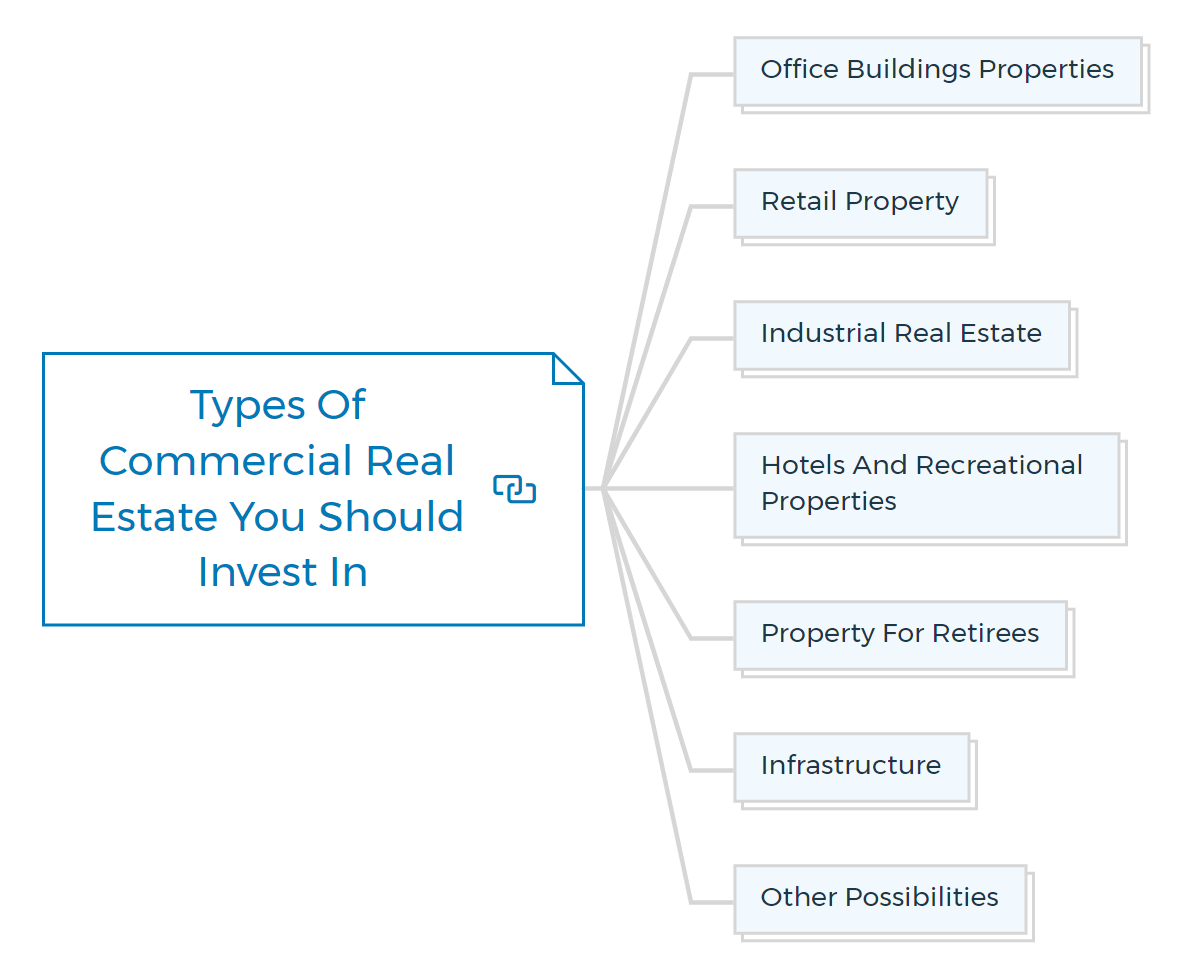
Office buildings properties
Office building yields differ by region. Certain market groups, such as government tenants in Canberra, media in Sydney, the financial industry in Sydney and Melbourne, and so on, are concentrated in specific locations, resulting in variances in-office requirements, rents, and returns. City growth is also an essential factor.
The rise of white-collar jobs is a significant element in driving trends in office space demand. When analysing office space, it's also vital to consider planned new construction, current vacancy rates, lease periods, and rental income.
You need to be aware of trends in the white-collar world as a seasoned investor interested in office commercial real estate investing. Retail tenants are increasingly demanding high-tech infrastructure.
There are also efforts to create environmentally friendly 'green' structures. Working from home and connecting with the workplace through a computer is another trend you'll be aware of.
Another issue is decentralisation. Some significant corporations think that a costly CBD presence is unnecessary and are relocating to the suburbs.
With the continued expansion of large strip malls, a trend toward transforming smaller suburban strip shopping locations into office space will emerge.
A growing strata office market is another trend, particularly in Sydney and Melbourne. Due to an increasing number of smaller property investors concerned that residential property has become unaffordable and oversupplied and a growing number of small business owner-occupiers, this has become a high-growth subsector. For buying a commercial property, some use their superannuation funds.
Retail property
The retail industry includes everything from huge shopping malls to strip shopping streets to your neighbourhood fish-and-chip shop.
Listed property trusts or major public property syndicates hold more than half of any city's shopping centre, making them accessible to small investors.
The retail sector in commercial real estate has historically exhibited robust growth. Most retail malls use long-term leases to ensure that profits remain stable, even during economic downturns.
Shopping malls are also putting a greater emphasis on leisure and entertainment options and remaining open longer. When evaluating a shopping centre, it's critical to evaluate the 'anchor' tenants, typically supermarkets or department stores with high foot traffic.
It's also important to consider the lease terms. The quality of centre management is also vital, though difficult to assess from the outside. Private investors looking for an investment opportunity to purchase a single commercial real estate asset frequently prefer small retail locations. Like those in residential real estate, interest rate trends are a factor.
A vital location is critical for investors looking to buy a shop or a collection of shops, as is a suitable tenant mix.
Industrial real estate
Modest workshops to vast international steel plants or oil refineries are all examples of industrial properties. The businesses themselves hold many, and the market's size is unknown.
Commercial property investors own more than $5 billion in industrial property, and there is an increasing number of listed property trusts to invest in this industry.
Industrial property yields have historically been more significant than other property types since many sites are custom-built for a particular tenant or activity. Finding a substitute tenant can be challenging.
On the other hand, tenants are hesitant to move because finding adequate new premises may be complex. As a result, the number of lease renewals is typically large.
You'll quickly notice that industrial property performance is heavily influenced by economic growth, despite other factors being at play. New transportation facilities can increase the value of some industrial property assets.
Because factories require little maintenance and continuous spending, the industrial sector appeals to many smaller commercial real estate investors wishing to invest directly in commercial property.
Hotels and recreational properties
Overseas tourists contribute significantly to any country's economic growth, and domestic tourism is another vital contribution. Nonetheless, it is a volatile industry driven by global economic conditions and quickly shattered by a new disease epidemic or terrorism.
Several publicly traded real estate investment trusts (REITs) specialise in hotels and leisure properties. Smaller investors interested in this industry might also join several property syndicates.
Property for retirees
Because of the ageing population, retirement property offers a lot of potential for investors.
Investors had limited options until recently, but that is changing. Some developers sell individual units to investors, then lease them back to the developer-operator.
Infrastructure
Most infrastructure assets, including roadways, airports, ports, power plants, and so on, were previously held by the government in almost every country.
With the privatisation of numerous public assets and a slew of new enterprises, a new wave of infrastructure property investment opportunities has emerged.
Australia has developed a sophisticated framework for producing so-called BOOT (build, own, operate, transfer) projects ahead of most other countries. The private sector takes on a significant development, eventually shifting to the public sector. Risk assessments and financial plans can be highly complicated.
Infrastructure corporations generally have significant debt levels due to the high expenses of projects. They may not pay out anything to their shareholders during the construction phase because they have minimal income.
Furthermore, high loan repayments during the early stages of business may limit dividends. Companies should, however, enjoy substantial revenues and be able to provide a regular stream of dividends in the future.
Infrastructure assets operate in a monopolistic or highly protected environment, providing critical services by their very nature. It is reasonable to believe that they will maintain their revenues well predictable as long as the economy remains strong.
They should increase in tandem with the economy, with the ability to pay substantial dividends bolstered by consistent debt repayments. Infrastructure properties, like property trusts, can be ideal investments for people seeking a continuous supply of higher income with a low amount of risk.
As the economy grows and the company diversifies into new ventures, there is also the possibility of some monetary gain.
Other possibilities
As commercial real estate becomes increasingly appealing to small investors, a plethora of new alternative investment options will emerge. Examples include health-care and day-care facilities. You can invest in a suburban doctor's office or a day-care centre if you have specialised skills.
Strata title parking spaces in multi-storey parking projects are a specialised investment that can pay off higher income for a small investment. They require little maintenance. Because they are generally in great locations, you can sell them for redevelopment at a profit.
Office, retail, and industrial assets are the best commercial real estate investing opportunities to generate passive income. However, as an investor, you should be aware of a slew of alternative options that are rapidly expanding.
One example is tourism and leisure properties. Another significant subsector is health care, day-care, and retirement buildings. A growing number of infrastructure projects are becoming available to small investors.
Looking ahead, long-term storage facilities are still a small but rising property market in Australia, but not in the United States, where you will find multiple self-storage real estate investment trusts on the stock exchange.
Influences on commercial property & real estate
The status of the economy has an apparent relationship with the performance of the commercial property. Demand for consumer goods in different markets rises as the economy grows, and merchants and their suppliers require more significant (and better) structures, factories, shopping malls, recreational facilities, and so on.
Similarly, a downturn in the economy might harm this market sector. Because of the significant lead time associated with office development, it is less susceptible to short-term volatility. Thorough market research is always helpful.
Interest rate levels are crucial in commercial real estate, just as they are in residential real estate. As borrowing becomes more affordable, there will undoubtedly be increased demand for new and existing commercial property.
At work, there are also other tendencies. An expanding suburb will attract new and renovated commercial centres and offices, and new highways or rail lines will develop new business parks.
Technology has a significant role as well. The designs of modern office buildings provide access to the most up-to-date telecommunications and technology. Tenants are becoming more accustomed to this. Another trend is the rise of 'green' structures, reducing greenhouse gas emissions.
6 Ways to invest in commercial real estate
Now that you understand more about commercial real estate and how it is better than other investments. Let's look at six different ways you can get involved in this market to begin investing.
Each method has its unique benefits and risks that you should carefully consider before deciding on the commercial property investment.
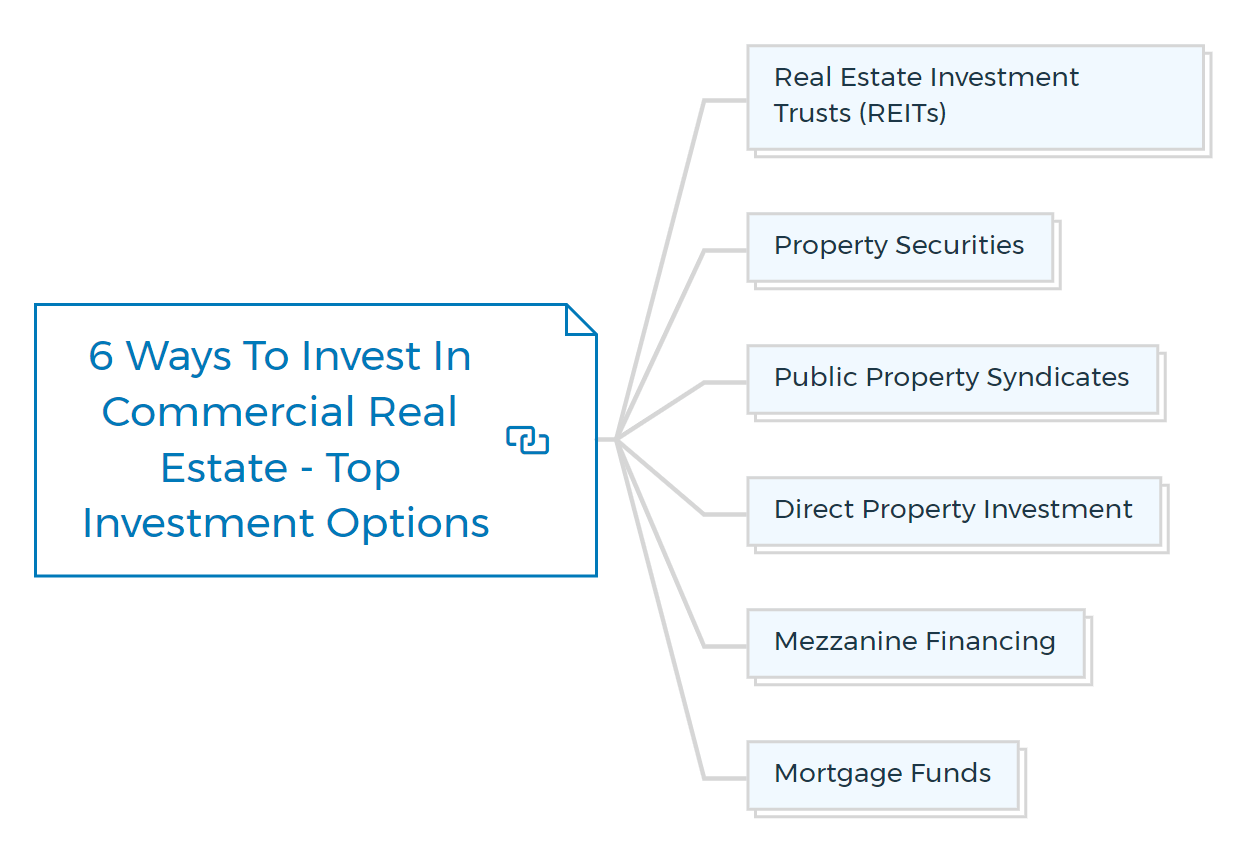
Real estate investment trusts (REITs)
Listed property trusts or REITs is the simplest way to invest in commercial real estate. It requires little more than creating an account with a stockbroker, putting some money, and then placing an order.
You can theoretically buy as few shares as you like. In reality, broker fees make purchases of less than $1000 impractical. Even with that amount, with a brokerage charge of roughly $30, you'll need a 3% return to break even.
Property securities
Property securities are professionally managed funds that invest in a portfolio of publicly traded real estate trusts. They're especially well-suited to conservative investors who aren't sure which property trusts to invest in. Investors use a product disclosure statement (PDS) to make the purchase.
Public property syndicates
Investing in a public property syndicate is also straightforward, requiring only the submission of a prospectus. However, it frequently necessitates a sizable initial investment, typically in the range of $10000.
The investment locking period is for the duration of the syndicate (unless you can find someone willing to buy the investment from you).
Direct property investment
Direct property investment is for someone who has done their homework and knows the market. You could buy a real estate property for as little as $100,000, albeit that sum would not get you very far. After that, you can put as much money as you want into it.
The supply of funds for commercial real estate developments is known as mezzanine finance. As the name implies, it entails providing cash between the developer's equity and mainstream commercial lenders.
As a result, it has a higher level of risk and the possibility for higher returns than traditional mortgage financing.
Mortgage funds
Mortgage funds are professionally managed funds that lend money against real estate. They provide investors with protection and potentially higher returns than a bank term deposit or cash management account, but no capital gain exists.
Direct vs Indirect commercial real estate investments
Direct property investment is a full or partial ownership interest in real estate. It also includes property syndicates. Indirect property investment usually involves buying stock in a public or private company like a real estate investment trust (REIT).
Most real estate investors believe there isn't much of a difference. A listed property trust and a property syndicate may control portfolios of strikingly identical properties. However, investment results can vary.
The main point is that most property trusts are traded on a stock exchange and are thus vulnerable to the whims of the money market. Prices fluctuate daily.
On the other hand, direct property prices depend on professional valuation, and the evaluated value may lag in times of inflation. As a result, listed trusts have significantly more volatility than direct property investments, implying more risk.
According to one study, listed trust values can fluctuate by up to 30% each year, compared to an average yearly change of 8% for direct property investments. In contrast to direct property investment, the listed property is highly liquid.
It would help if you considered timing difficulties. To pump cash into the economy during a slump, the government may decrease interest rates and acquire short-term securities. It tends to pass through to the money market even before the economy recovers, resulting in a favourable impact on listed property trusts.
On the other hand, direct property tends to move later in the economic cycle when the economy is well on its road to recovery.
Get The Edge Now!
Discover the transformative power of our FREE EDGE platform and
unlock a world of opportunities at no cost!
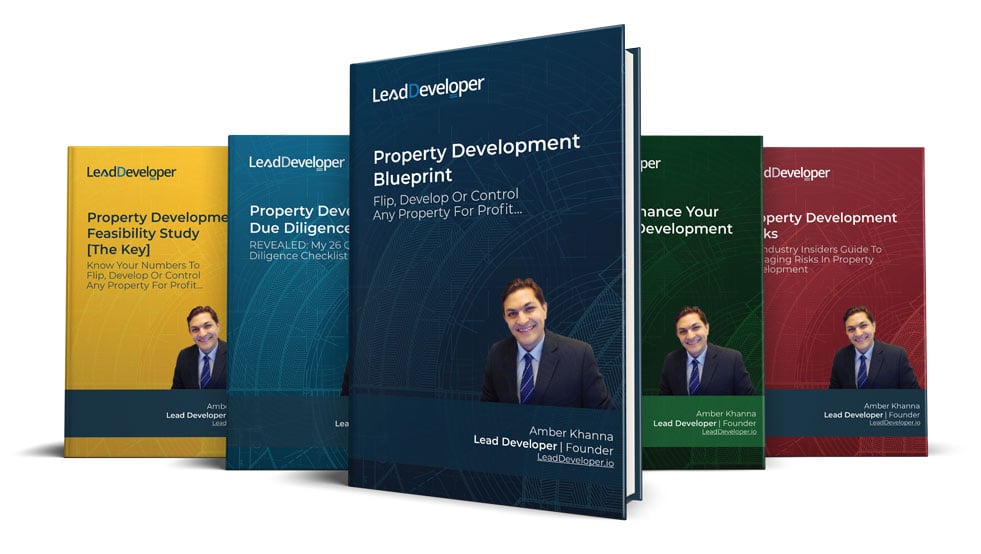
Your Real Estate Toolkit Awaits!
Free eBooks, Courses & Feasibility Suite Trial—Join Today!
✓ Unlimited FREE Trial: Experience the full power of our Feasibility Suite with hands-on demos
—explore without limits, no time pressure & without commitment or credit card!
✓ Learn from Success: Dive into real-life case studies for practical insights.
✓ Engage, Inquire, and Innovate: Ask questions, request features, and engage in lively discussions.
✓ Showcase Your Projects and Gain Insights: Share your projects and get personalised feedback.
✓ Free Resources Galore: Access a treasure trove of free resources,
eBooks & courses to keep you informed.
✓ Exclusive Training: Enjoy members-only training to sharpen your skills.
Profit sources in commercial real estate investments
Commercial real estate investors need to know where their revenues come from.
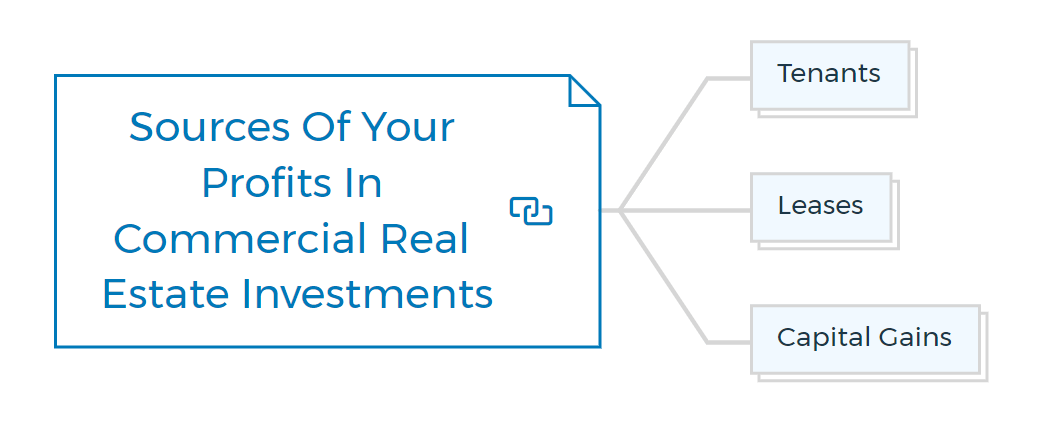
Tenants
The tenants, in general, are crucial since they provide a consistent source of income. As a result, locating trustworthy tenants is critical, knowing their needs and providing appropriate housing.
If you own commercial property, you must understand what tenants anticipate. Also, because good tenants are such an essential element of the profit equation, it is feasible to raise the property's worth by changing it—say, an upgrade or a change of use - to attract better renters.
Leases
The lease's conditions are crucial. A decent lease will usually include rental increases that are at least in pace with inflation or economic growth. It could contain provisions that prohibit the reduction of rental income during a downturn in the economy.
The lease should also include regular rental reviews, with such reviews depending on market conditions.
The lease length varies, with shorter leases being more common in smaller spaces, but the minimum is usually three years. A typical rent duration for large office buildings is 5 to 10 years, with the option to extend for another period.
The lease duration for a large or purpose-built factory might be ten years, with the option to renew for another ten.
Capital gains
Capital gain is the other primary source of earnings. It will not always be as high as what can be expected from residential real estate (because of the different supply and demand equations), but the possibilities are there.
Commercial properties in a given area can have considerably increased demand, just as some areas can fall in and out of vogue with homeowners. As a result, the value of stores in a high-growth neighbourhood may rise, while the value of industries and offices may rise due to increased mobility.
Best short term strategies for commercial real estate investing
Commercial real estate investing is often a long-term asset class that pays a high and consistent return. Because it is somewhat illiquid (save for listed property trusts), it is often unsuitable for short-term trading.
Nonetheless, a knowledgeable and experienced real estate investor might locate homes that can be upgraded and promptly sold for a profit. Typically, this entails increasing the property's income flow and the security of that income flow, so increasing the property's value.

Buy run-down property and renovate it
You can accomplish this in a variety of ways. The most basic is to purchase a run-down property and renovate it. A savvy investor may be able to locate a property with a lease that does not represent current rental rates.
Renegotiating the lease could result in a higher rent, increasing the property's value. Longer leases and higher-quality tenants, such as a large grocery chain, can increase the value of a property.
You may find some poorly managed property. For instance, a block of stores could have a vacancy or tenants that don't generate much revenue. Making the stores more desirable to better tenants can increase the rates.
Opportunities in neighbourhoods
Another smart short-term strategy is to look for opportunities in developing neighbourhoods or in neighbourhoods such as inner-city suburbs attracting an increasing number of up-market people.
Buy and develop vacant land
You can buy vacant land and develop it, or buy a vacant building and locate tenants if you have the right experience. With a bit of innovation, enterprising investors might be able to radically transform the purpose of a property—converting a warehouse into a restaurant, for example—increasing its value. This way, you can make the best commercial deals.
Timing the market
Another feasible short-term method is timing the market. Like the money market, commercial property can experience a long period of little change in value, followed by a period of rapid increase. For this, you need to understand the commercial property cycle.
commercial property cycle
If you follow the stock market, you're probably aware of the so-called investment clock, which claims to indicate how the economic cycle affects equities.
As a result of the overheating economy, interest rates rise, and stock values plummet. Then, as the economy deteriorates, interest rates fall, and stock values increase again.
Several analysts have proposed a similar 'clock' for commercial real estate. However, the outcomes aren't that useful. There are numerous components to commercial investing, and they do not always operate in lockstep.
Industrial property prices, for example, may fall while retail space prices are rising. Regional differences exist as well. Prices in Sydney may be scorching, while in Melbourne or Brisbane, they are tepid, or vice versa.
Using a broad-brush approach, however, it is conceivable to place the property in the investment cycle as follows:
- The economy begins to slacken.
- Direct property prices have plateaued and may even be declining.
- The government injects money into the economy.
- The stock market and publicly traded real estate investment trusts are both rising.
- The economy begins to improve.
- Direct property prices are beginning to soar.
- Inflation could also increase.
- Increase in interest rates.
- The money market and publicly traded real estate investment trust both drop.
4 Phases of commercial real estate
There are four phases for commercial property based on economic and supply-demand dynamics, which are crucial for a commercial real estate investor. The following are the details:
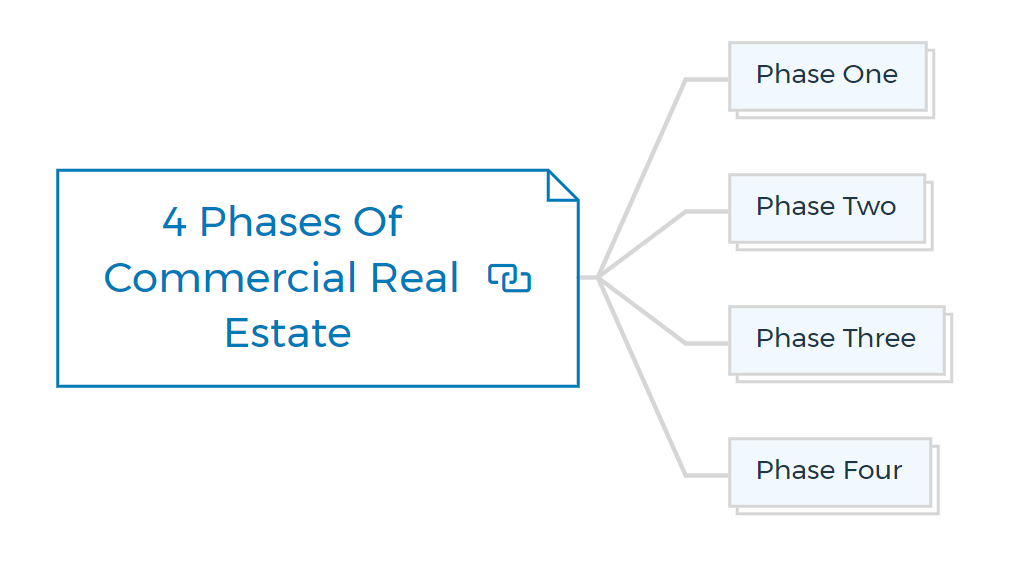
Phase one
Begins at the bottom of the cycle when the market oversupplies due to a weak economy and too much new building from when the economy was still robust. Vacancy rates are likely to be high, and rents are likely to be declining.
However, new construction generally comes to a halt during this time, while demand gradually recovers and the existing overstock is progressively absorbed.
Phase two
Demand for new space grows, but rents rise- sometimes dramatically due to a lack of new building. It prompts developers to begin the construction of new structures again until supply and demand have reached a rough equilibrium.
Phase three
Demand is increasing, but supply is increasing at a higher rate; therefore, rental growth may stall.
Phase Four
The market is approaching oversupply due to overbuilding, which a faltering economy may exacerbate.
Get maximum returns through commercial real estate - 11 crucial steps
Here are the 11 most essential steps to help you get maximum returns on your commercial property investment. By following these tips, you can rest assured that you're making the most of your money while buying commercial property.
Step 1: Gaining the commercial real estate knowledge
You must swiftly obtain the requisite commercial property knowledge and experience as part of the procedure. Some professional investors pursue a tertiary degree in property, which entails three years of full-time study and covers a broad range of topics.
Macroeconomics, commercial and property law, accounting, valuation principles, statistics, business computing, commercial space, secure financing, urban economics, business forecasting, marketing principles, commercial asset management, business research, property investment, property development, urban valuations, and more are among the subjects covered.
That is what you will need to study if you want to completely grasp the 'knowledge' part of commercial real estate investing. And once you've built up your knowledge foundation, you'll need to combine it with years of practical experience to ensure you're fully prepared to take advantage of the market's opportunities.
Step 2: Develop your investment strategy
With some insights on emerging property investment and development trends, you're sure to come across some commercial real estate investing opportunities.
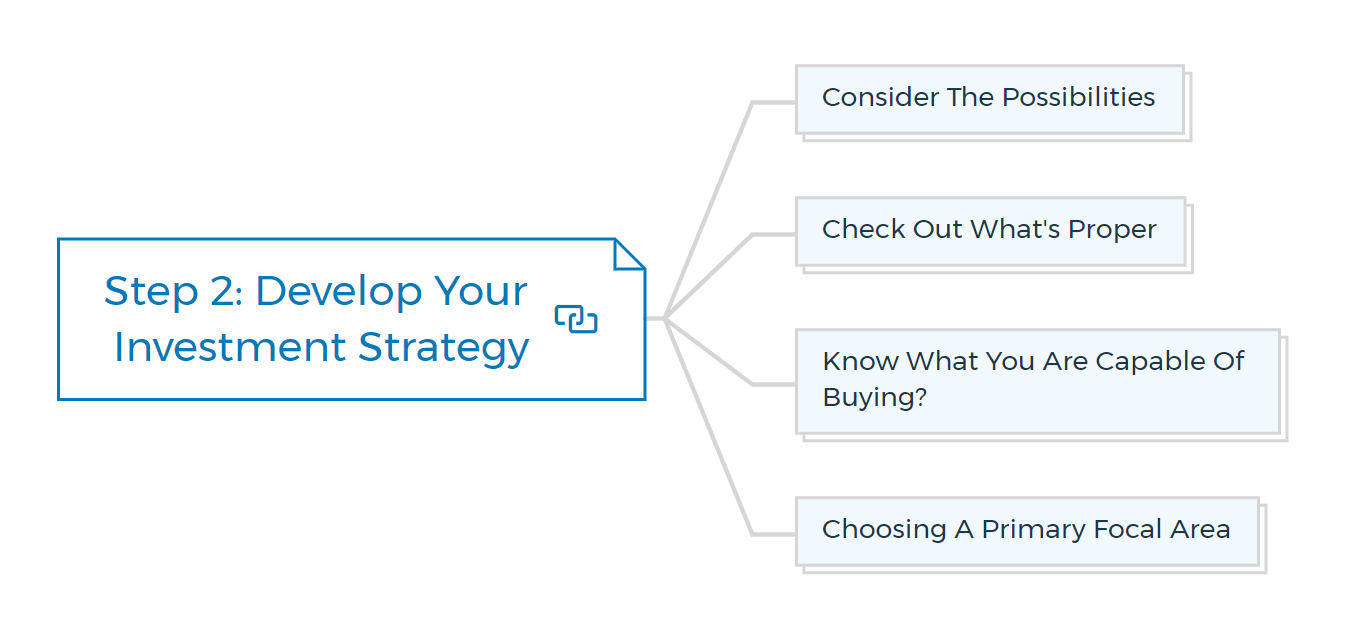
Consider the possibilities
You now have many potential paths (or alternatives) in front of you. And perhaps you could display them in a simple graphic, with the image containing all of your alternatives.
On the other hand, creating your investment strategy may look to be an intimidating undertaking at present, simply because your options appear to be too many.
Check out what's proper to get into commercial real estate
You know what's conceivable, but you need to narrow down your options. And you can do so by asking yourself, "Which of the different available possibilities best suits my temperament?"
Although a sound investment option may appear enticing, this is not necessarily a good reason to pursue it.
For some people, borrowing 90% of the cost of a worthwhile investment is acceptable. On the other hand, a borrowing ratio of more than 50% of the cost would cause considerable distress to others.
As a result, you'll need to figure out what we'll term your "insomnia threshold." As a result, you begin to understand better the kind of investments you should include in your portfolio.
That doesn't mean you should stick to old habits, even if they're the ones that make you feel most at ease. However, by introducing the concept of appropriateness, you may begin to narrow down your newly discovered possibilities.
When you compare what you perceive to be appropriate investments to potential property investment opportunities, you'll be able to narrow down your options to something much more doable.
Know what you are capable of buying?
You must now assess your resources, both monetarily and in terms of time. That doesn't mean you have to limit yourself to seeing alone. You might want to consider forming a syndicate with other like-minded investors and property managers to leverage your funds and share your risk.
To avoid spreading yourself too far and running yourself tired, you will, like most serious investors, need to hire professional property management expertise as your portfolio grows.
But, assuming you've decided to invest on your own for the time being, you'll need to correctly examine your available money, which will be a combination of your current cash and any further equity you may have in other properties. Your diagram should now resemble the one given below.
Choosing a primary focal area
As you can see, after applying these three 'filters,' you're left with what's possible, what's suitable, and what you're capable of investing in (in the centre of these overlapping circles). Only then will you be able to begin accumulating property riches.
Contrary to popular belief, the smaller your list of potential investments, the more focused and successful your real estate investment approach will be. It's a simple procedure, but one designed to assist you in determining your primary area of interest!
And it's a procedure that even seasoned commercial property investors go through now and then to keep themselves on track.
Like all types of investments, buying commercial real estate requires a strategy. Decide what kind of property you want to buy (office buildings, retail space, industrial warehouses, etc.), what your budget is, and how you plan to finance the purchase.
Having a clear plan will help you stay focused and make wise decisions throughout the commercial real estate buying process.
Step 3: Research the market
It's essential to do your research before buying commercial real estate. Read market reports, consult with experts, and look at past sales data to understand where the market is going.
It will help you make informed decisions about which properties to target and how much you should offer for them. While researching for rental or commercial real estate markets, consider the following indicators -

Population growth
An increase in the population often indicates a healthy real estate market. When people from out of state migrate to an area, the commercial real estate market is often inundated and turned into a seller's (or landlord's) market, which means you have an opportunity to profit from a once-in-a-lifetime investment opportunity.
The revitalisation of the city
Taking advantage of the real estate market during a city regeneration period is expected. The internet has become a valuable resource for people seeking commercial real estate investing opportunities.
Finding a market that satisfies the above two requirements is more accessible when dealing with a competent financial advisor.
Step 4: Working with the right team
One of the most significant advantages of commercial real estate is that - it is a team sport. To succeed in this market, you need to partner with people who have expertise in financing, development, and property management.
Finding the right partner can make or break your strategy - so take your time and find someone you can trust.
Step 5: Deciding on a suitable property
Given many properties available, you'll need to stick to some tight standards. By doing so, you will simplify your decision-making process and add some consistency to your decisions.
To put it another way, you'll need a simple framework for locating and filtering available properties. There are some specific buying criteria that you should know to make this process easier.
Step 6: Do your due diligence
Commercial real estate investors that are seasoned turn over every stone to eliminate the chance of post-transaction surprises. Newcomers should follow the same strategy and avoid rushing into a contract, given the various dangers involved.
Commercial real estate acquisitions necessitate extensive due diligence to find critical facts that may not be readily obvious or available when determining a property's or portfolio's value.
With thorough due diligence, you can crunch numbers quickly. Check out the 26 questions due diligence checklist that you can use whenever you want to make a purchase; you'll be able to avoid most of the frequent property investment errors.
Step 7: Analyse potential properties
It can be the most perplexing and frustrating aspect for a real estate investor. You've found a few commercial properties that appear to meet your aims and criteria, but you don't have a quick and easy way to narrow them down to a manageable shortlist.
Follow an approach that will assist you in grading your investment options. It simply integrates your objectives and criteria into a compact matrix, allowing you to score each of your potential properties quickly. Then, you must develop a predicted (four to ten-year) after-tax cash flow for each property. Unless you have financial analysis abilities or the necessary complex computer software, this is a job for a professional.
The financial forecast would take into account the following factors:
- Price of purchasing
- Cost of acquisition
- Monetary borrowings
- Costs of interest
- Net rental
- Depreciation
- The expected sale price
- A tax on capital gains
- Costs of selling
Before buying commercial property, some property consultants or financial advisers will prepare cash flow predictions for you as a matter of course.
Then, you can calculate the internal rate of return (the expected, after-tax percentage return on the actual equity you invest) for each property using those projections.
Step 8: Make a financial plan
Before making any purchase proposal for commercial property, you must have your financing in place. Or, at the very least, be confident that your financial source will approve your request.
One or more banks may already have a relationship with you (as most people do). They'll not only look after you but will also offer you the most outstanding deal, given your long-standing relationship. Right? Maybe! But this isn't always the case.
I recommend you to speak with a few real estate brokers and financial advisors who can help you arrange your finances.
You should include the following in your plan for secure financing:
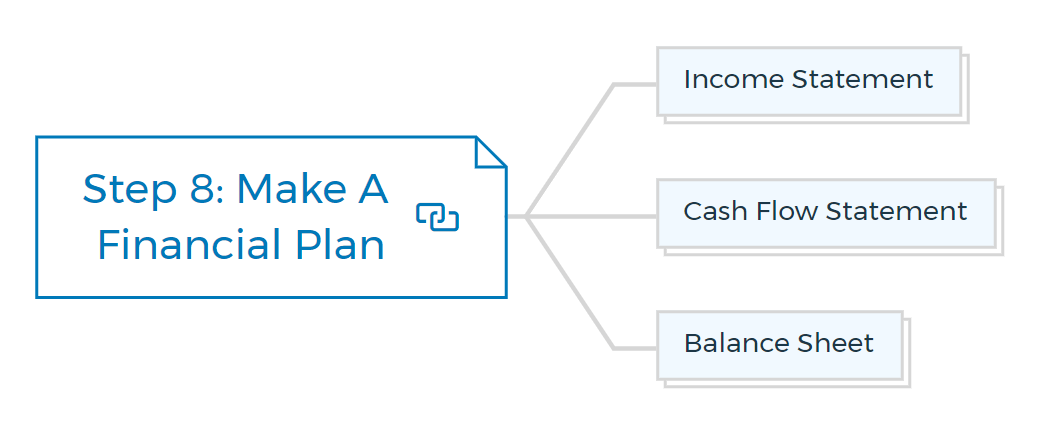
Income statement
It is an inventory of your current income versus your expenses, also known as a profit and loss statement.
Cash flow statement
This document details the difference between generated and spent cash to determine whether your organisation has positive or negative cash flow.
Balance sheet
The balance sheet depicts your company's net worth to any loans and obligations.
Step 9: Make an offer and negotiate
If you're in the market for a commercial real estate property, it's essential to make an offer and negotiate with the seller before buying. By doing this, you can get the best deal possible and ensure that you're getting what you want from the property.
Work with your commercial real estate broker or agent to come up with a fair price, and don't be afraid to make an offer that's lower than what you're willing to pay. By negotiating early, you can ensure you get the property you want at a price you're comfortable with.
Sellers have been on the market for some time and are likely eager to conclude a deal. You can substantially increase your chances of success by preparing an offer package with all of the necessary information included:
Your structure of the offer
- How you will finance the purchase
- A thorough due diligence
- Why this property is a good investment for you
Commercial properties are often unique, so it's essential to be flexible during negotiation. Remember, even if you face rejection with your first offer, it's not the end of the process. You can always come up with another offer.
Step 10: Profitably manage your property
You don't make your profit when you sell a property; you make it when you acquire it!
To a significant extent, the above saying is correct. You can, however, acquire a commercial property well and then manage it poorly, losing a lot of money in the process.
If you decide to manage a commercial property on your own, you'll need to gain a thorough understanding of tenancy legislation, statutory rules, and construction.
The Essential Services Regulations—legislation covering monitored services within a building, such as air conditioning, fire services, elevators, and electrical equipment—is one of the primary areas of significant risk for landlords.
The owner will face severe fines if you do not comply. With so many new modifications, this is an area that might result in a wide variety of penalties.
That is why most active property investors opt to have their properties managed by a professional property manager.
Step 11: Market your investment property
By purchasing commercial real estate, you may have made a good investment. Also, the property has been well-managed either by you or your property management company.
Still, it will be an imaginative and highly professional marketing effort that will put the "icing on the cake" and help you get the most out of your commercial real estate investment.
That is why you must use caution when choosing an agent or consultant to advertise your property, as not all agents are up to date on current trends in property marketing in the twenty-first century.
What is residential real estate?
Residential real estate is any property designed for housing purposes. It includes single-family homes, multi-family homes, town homes, and more.
Residential real estate investing can be a great choice because it often has a lower risk than commercial real estate. Additionally, residential real estate can provide a steady income stream through rental payments.
Commercial vs Residential real estate - 14 differences
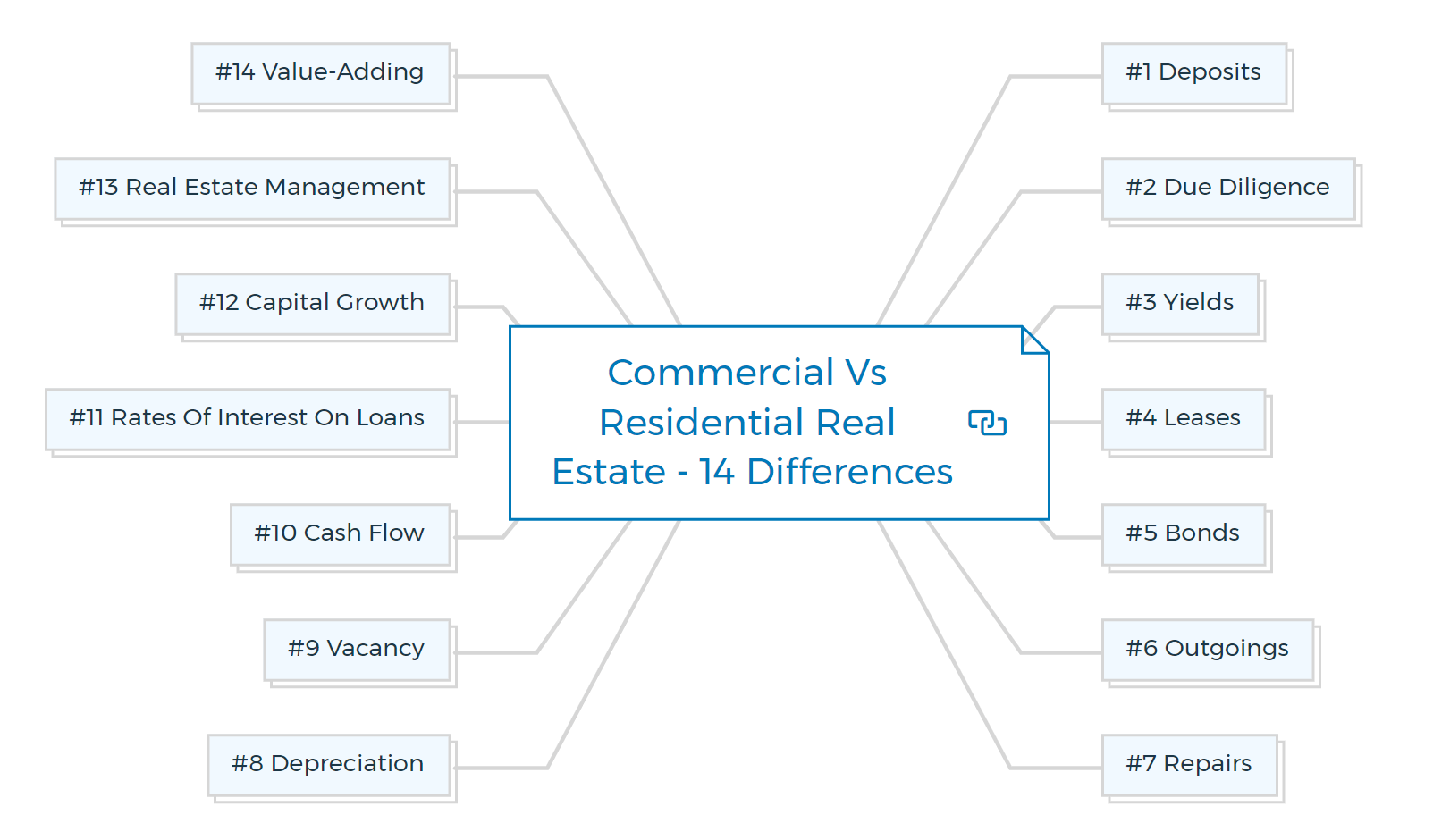
Now that we've gone over residential vs commercial real estate investing basics, let's dive into the 14 significant differences between residential and commercial real estate investing.
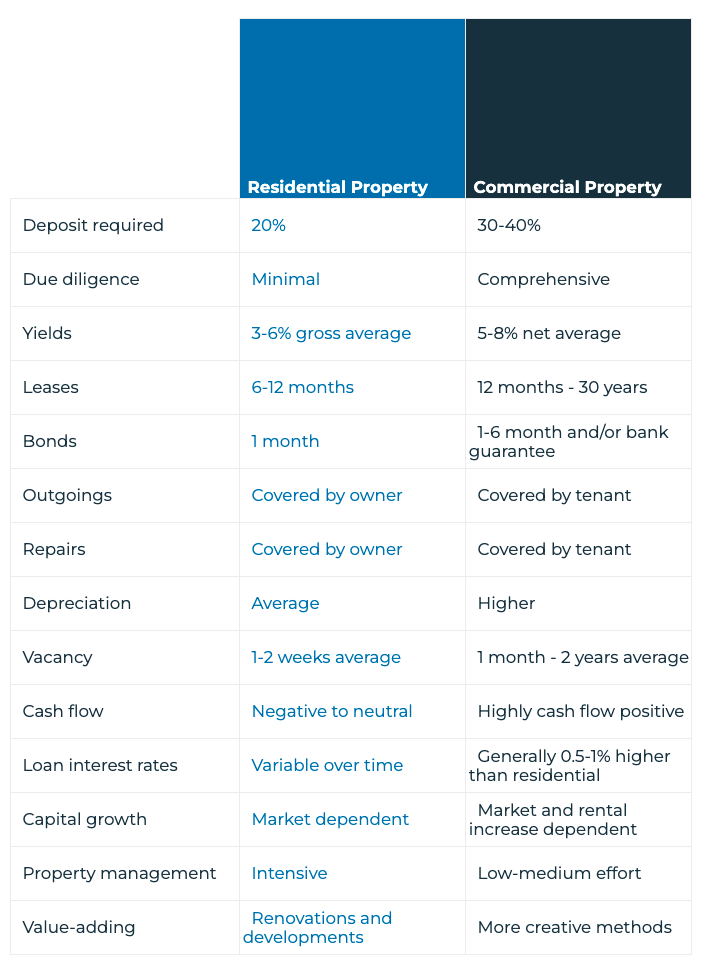
#1 Deposits
You'll need a more significant deposit for commercial property than for residential. Commercial property lenders often accept a loan to value ratio (LVR) of 60 to 80 per cent, whereas residential property lenders allow LVRs of 80 to 90 per cent or even 95 per cent.
In other words, a house or apartment will require a 5 to 20% deposit, whereas a commercial property will require a 20 to 40% deposit. As a result, the first perceived disadvantage of commercial property is the high entry cost.
In fact, for something like a car park or regional office, the entry-level for commercial property can be as low as $50,000. You can also purchase industrial space for as little as $150,000 in major cities.
Another factor that real estate investors sometimes overlook is that they can recover the additional deposit necessary for commercial property within two years through cash flow alone.
If your assets limit your borrowing, investing in commercial property will allow you to borrow with less leverage because they require a larger down payment and a lower LVR.
However, if being able to service the loan is your primary concern, commercial property offers financing options that residential real estate does not.
#2 Due diligence
Due diligence is the next big thing in commercial vs residential real estate investing. The amount of due diligence required for a residential purchase is minimal once you've chosen the area.
A building inspection and a few other inspections, such as if the property is in a flood zone, are usually included. If the chosen region is desirable, the property's value will likely rise with the market.
On the other hand, commercial properties necessitate a great deal of research. You'll need to examine and consider the asset type, the vacancy rate for that asset type, the foot and road traffic surrounding it, and conduct building inspections, a lease review, and a tenant review.
#3 Yields
The most frequently mentioned topic is higher yields for commercial real estate. Residential real estate returns are often expressed as gross yields, whereas net yields are in commercial real estate.
The gross yields on residential property are generally between 3 and 6%, and owning residential real estate comes with many expenses, including council taxes, water rates, corporate body costs, and maintenance. After the outgoings, the net yield could be as low as 1% to 3%.
On the other hand, commercial properties will have a net yield of 5 to 8% on average. The term "net yield" refers to the renters being typically responsible for 100% of the outgoings.
As you can see, with commercial real estate, you can get a significantly higher net cash-flow return. One of the main reasons commercial real estate investors want to create a portfolio is this.
#4 Leases
Commercial leases are more perplexing than household leases. It may have been the case in the past because leases were rather complicated, but they are now relatively standard and much easier to comprehend.
On the other hand, a solicitor should review commercial leases, whereas you and the property management can review residential leases. Residential and commercial leases can be as little as month-to-month.
However, residential leases are usually 6 to 12 months long, whereas commercial leases can last anywhere from a year to 30 years. Tenants in residential buildings seek the freedom to move if their circumstances change.
On the other hand, commercial renters require the assurance that they will stay at the location for the long term, as their business and livelihood are dependent on it.
#5 Bonds
A one-month bond is common for residential homes, whereas a one- to six-month bond is common for commercial buildings. They can also have a bank guarantee for ensuring the fulfilment of the lease.
A bank guarantee is a legal assurance from the tenant's bank that if the tenant fails to fulfil their responsibilities under the lease agreement, the landlord will receive a certain amount of money.
It's worth mentioning that evictions for residential real estate can take months and entail intricate legal procedures. Because the property is not their home, evicting a commercial tenant is frequently more accessible and less red tape.
#6 Outgoings
The majority of costs, such as council and water rates, repairs, and maintenance, are borne by the residential property owners. When it comes to commercial real estate, the tenant is usually liable for most of the outgoings, resulting in a substantially higher cash-flow return for the owner.
#7 Repairs
Residential tenants rarely treat the property as if it were their own, resulting in increased wear and tear and higher maintenance costs for the owner. It can also cost tens of thousands of dollars to renovate a home - replacing old kitchens, bathrooms, and carpet can be very costly.
On the other hand, commercial rentals are usually responsible for the property's inside fit-out and shopfront. The tenant's lease might also be related to the property's appearance such that they need to maintain it or risk having their lease terminated.
Commercial rentals will generally look after the premises because they have paid for the fit-out and maintenance. Because the state and appearance of the property reflect on the business, it's more likely that they'll take care of it to make a positive first impression on their consumers.
They are also responsible for the property's health and safety (worker and customer safety) and are more likely to use security systems such as alarms, security guards, and CCTV. The property will not be left unattended for an extended period without your awareness.
Still, residential rentals may leave overseas, leaving the property vacant and subject to intruders, uncontrolled fires, and other hazards.
#8 Depreciation
Surprisingly, depreciation is tax-deductible for all real estate investments, including commercial. It is an advantage that no other asset class possesses.
Commercial properties usually have more depreciation due to the more expensive construction and fit-out, which can be an advantage because higher depreciation equals more significant tax savings for the owner, depending on the age and type of the building.
#9 Vacancy
Considering vacancy is essential while looking for commercial vs residential real estate investing. The gap in vacancy rates between residential real estate and commercial real estate is significant.
The vacancy rate for residential houses in a well-chosen region usually is between one and four weeks each year. Because of the shorter leases, there will be a higher tenant turnover, as tenants may opt to move for employment because they have received a raise or lost their job, buy a property, or because their relationship status has changed.
On the other hand, commercial tenants are less likely to relocate. It is because their livelihood depends on the business, and they've already paid for the fit-out. However, in a high-demand region, commercial buildings often have a vacancy rate of one to six months.
Doing it wrong in commercial real estate can result in protracted vacancy periods. Having suitable real estate agents and effectively pricing the rent will help you lease the property faster for vacant homes.
It's crucial to consider whether you'll be able to repay the loan if your tenants leave. Of course, this applies to residential real estate, but residential property will have shorter, more consistent vacancies than commercial real estate, which will have more extended, less consistent vacancies.
Some say that commercial investing is riskier in terms of vacancy, but this is only true if you've purchased a risky property, such as a residential investment property in a mining town whose rental demand is related to the status of the resources sector.
Even if you have solid commercial real estate, you'll need a more significant cash reserve to cover things like lengthier periods of vacancy, property upgrades, or rental concessions (such as rent-free periods for tenant fit-out).
#10 Cash flow
You will find most residential properties negatively geared, which means you're losing money in the hopes that capital growth will compensate for it. You might have trouble repaying the loan if you buy this manner, and you'll need to keep your work to be able to pay the mortgage.
Even if you find some good-quality neutrally geared or slightly cash-flow positive residential properties, banks will apply a serviceability criterion to your portfolio, which will result in a negative cash flow in their perspective.
Commercial real estate investing generates a lot of cash flow, and servicing the loan isn't as tricky, so you may keep growing your portfolio as an investor.
#11 Rates of interest on loans
When opposed to residential loans, commercial loans will typically have higher interest rates. It will generally be between 0.5 and 1% higher; however, this will vary greatly depending on the type of loan, deposit size, property type, and risk.
Commercial loans have slightly higher interest rates since they have a shorter loan term (e.g., amortised over 20 years instead of 30 years), which dramatically increases monthly mortgage payments.
They also have a smaller secondary market, which means less competition among lenders to offer a higher rate.
#12 Capital growth
There is a common misconception that commercial properties do not appreciate at the same rate as residential homes. There would be a significant pricing disparity if this were the case. But it's simply not true. Most commercial properties have grown as fast as residential, albeit on a distinct cycle.
Residential real estate relies solely on capital growth for generating a net return. Over the last 30 years, the average annual capital growth rate of property in Australia's big cities has been 5.3 per cent.
Residential real estate is often cyclical, with intense, low, no, and even negative growth periods. On the other hand, rented business property is more likely to have a consistent revenue. Capital growth can be cyclic, but it has a different nature.
As the cost of most residential homes in different cities rises, investors' dreams of owning a home are slipping away as it becomes increasingly unattainable.
The common perception is that commercial real estate investment is stagnant, but this is not true. If this were the case, you would be able to buy considerably more inexpensively in the commercial market than in the residential real estate market.
Different commercial asset classes indeed expand at different rates, but there's much more to it than that. Commercial real estate investment depends on quantitative algorithms rather than market growth fundamentals. Residential real estate investment depends on the expectation of future growth.
#13 Real estate management
Because the tenant is usually just responsible for their electricity bill and council rates, managing residential homes takes a lot of effort. The owner must pay all other expenses and maintenance.
Commercial properties typically have renters responsible for outgoings and maintenance, so the owner has less work to do. As previously stated, the tenants' livelihood is also dependent on the property; therefore, they are more likely to look after it.
#14 Value-adding
Investors in residential property frequently refurbish or purchase larger blocks to add granny flats or even subdivide the property. While these ventures can be profitable, the investor's contribution is usually limited.
A commercial building can be developed in various ways, depending on the asset class purchased. Changing the property's use, adding more tenancies, raising the rent, generating new revenue streams such as installing ATMs or solar panels, renting out parking, storage, or advertising space, or adding mobile phone masts and repeaters are all possibilities. Commercial real estate is far more adaptable.
What are the benefits of investing in residential real estate?
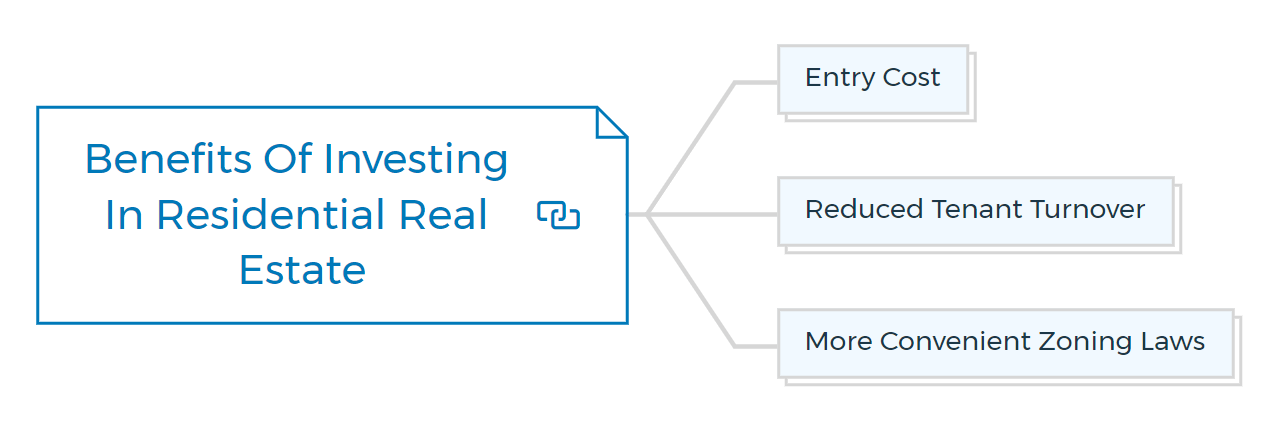
Entry cost
While it is feasible to secure commercial real estate loans as a first-time investor, the cost of residential real estate investing is almost always less than that of commercial real estate – at least initially.
The average person may not have enough money to put down on a commercial property. Still, they are considerably more likely to have enough money to put down on single-family homes.
If the idea of investing in a commercial property seems intimidating to a rookie investor, consider this: once an investor has purchased multiple cash-flowing residential properties, they will most likely have the capital and experience needed to invest in a commercial facility.
Reduced tenant turnover
Tenant turnover isn't something that many residential real estate investors deal with, mainly if they specialise in single-family houses. Businesses adapt and grow, and the tenants that make up commercial buildings do as well.
It might be tough to keep tenants for long periods when the real estate market is volatile. It means that finding tenants regularly rather than once in a blue moon will require more effort.
In reality, as a residential real estate owner, you may locate folks devoted to being long-term renters, provided you promote and screen tenants effectively.
You can be more confident that long-term tenants will treat the property as if it were their own if you focus on obtaining only long-term tenants.
More convenient zoning laws
As a property owner, you'll have to deal with a lot more red tape when it comes to commercial investing. Zoning restrictions are tighter, building licences are harder to come by, etc. The rules and regulations governing residential real estate are more flexible and small.
Risks in Residential vs Commercial properties
The risks of commercial real estate are higher than residential, but the returns can also be more significant. If you're considering commercial real estate, you must have a higher risk tolerance and be comfortable with a more extended lock-in period.
Below is a short comparison of risks in commercial vs residential real estate.
- The tenant is usually responsible for the property taxes and insurance in commercial real estate, while the residential property owner must pay these costs.
- The commercial property value can be more volatile than residential real estate property.
- Commercial real estate projects typically have a higher initial investment than residential projects.
- It can be more difficult to find commercial tenants than it is to find residential tenants.
- Locking into a commercial lease for several years may limit your ability to sell or refinance the property during that time.
- There is always the potential for tenant default or bankruptcy, which could lead to loss of your investment in commercial real estate.
What type of investor should choose commercial over residential?
Commercial investors should have a higher risk appetite, be comfortable with more extended lock-in periods, and have more capital available than those investing in residential properties. Generally speaking, commercial investors should also know commercial property management.
Residential investors should expect lower risks and shorter lock-in periods when investing in residential properties. They should also have a good understanding of how to find, screen, and manage tenants.
Investors who are unsure about which type of real estate is best for them should consult with a professional real estate advisor.
Which is right for you - Residential Vs Commercial Real Estate
The decision of whether commercial or residential real estate is a suitable investment for you depends on several factors, including your risk tolerance, investment goals, and experience level.
Commercial real estate can be an excellent option for investors looking for a higher return on their investment and comfortable taking on more risk. However, it is essential to understand all the risks involved before making any decisions.
Residential real estate may be a better option for investors who are just starting or those who are not interested in taking on as much risk.
Ultimately, the best way to decide which type of real estate is right for you is to do your research and talk to a qualified financial advisor.
Bottom line
Hew! If you've made it this far, congratulations! You now have a solid understanding of what to do when buying commercial property. By following the steps outlined in this guide, you'll be well on your way to owning a property that will provide years of income and growth.
Make sure you have your finances in order before making any offers for buying commercial property- this will increase your chances of success. You should also be prepared for negotiations, as sellers are likely eager to conclude a commercial real estate deal.
Remember, it's essential to be flexible during the process and keep in mind that every property is unique. You can successfully invest in commercial real estate with careful planning and execution!
Whether you decide to develop a residential or commercial building, enrolling on structured property development courses would always be beneficial.
FAQs

